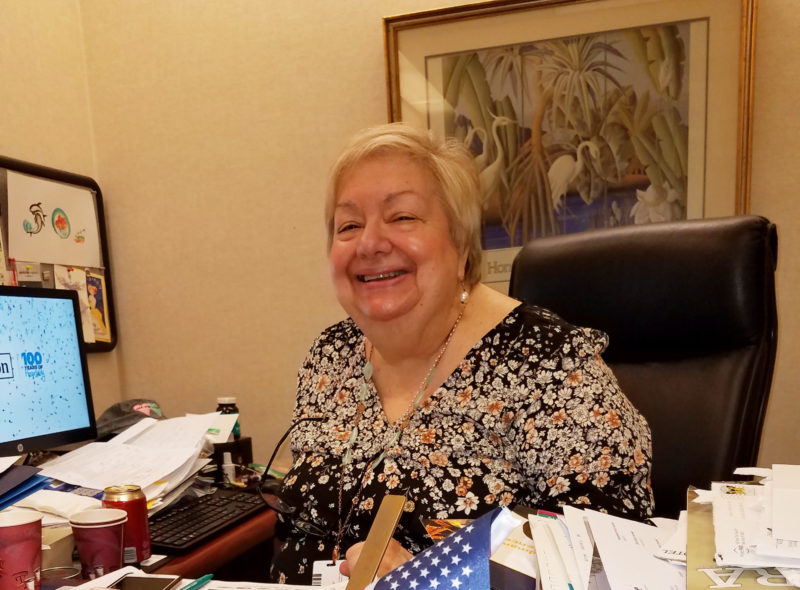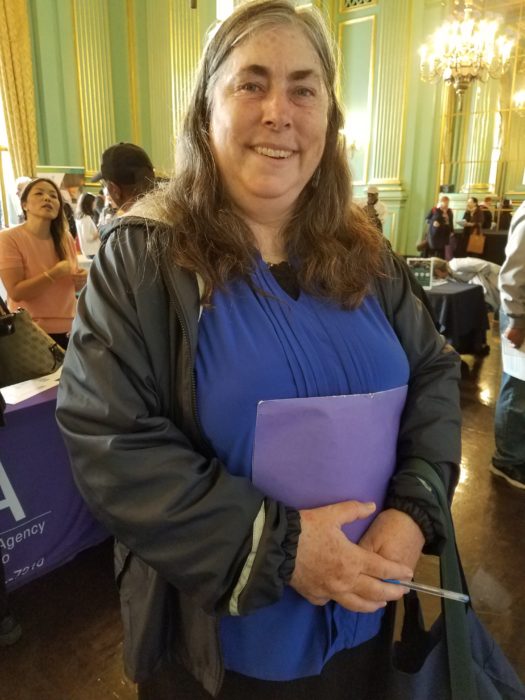Older adults grappling with layoffs and rising costs of living swell the workforce
EDITOR’S NOTE: If you know of any seniors who are, for whatever reason, still working – in the public arena or at home – and willing to share their experience, please contact robinevans@sfseniorbeat.com.
Once, or so the story goes, a cake and a gold watch signaled the end of one’s working life and the beginning of retirement. While you might have felt some sorrow at leaving your colleagues and a bit overwhelmed at the prospect of limitless free time, visions of sleeping late, pursuing hobbies, travel or time with grandchildren overrode your hesitations.
That’s not the case any longer. More than half of older U.S. workers are pushed out of longtime jobs before they choose to retire, enduring devasting physical and mental crises and suffering financial damage that is irreversible, according to a recent data analysis by ProPublica and the Urban Institute.
The Great Recession of 2008 increased the probability that those in their mid-50s would be laid off, says a 2015 report by the National Bureau of Economic Research. Involuntary job separations, across all racial and ethnic groups, increased sharply as workers grew older, according to a report by the Urban Institute, a Washington D.C.-based policy research nonprofit. Your chances of being laid off between age 50 and 55 is six percent. That increases to 22 percent between ages 62 and 64, and 43 percent at 71 and older.

The effect on workers and their families can be devastating, said Roderick Bushnell, one of the diminishing number of lawyers who will take age discrimination cases. “Their families fall apart. Who is going to pay the mortgage, the car payment, the college tuition? They have to move. They have to downsize. For many workers, this is a time when they have more debt than they ever have had in their lives.”
Ironically, layoffs and increased costs of living have contributed to an increase in the share of seniors in the workforce or looking to be. Workforce participation among 55- to 69-year-olds has grown by up to 7.6 percent over the last decade, according to the U.S. Bureau of Labor Statistics. But the starkest increases can be seen among even older groups: 12 percent for 70- to 74-year-olds and 26 percent for those 75 and up.
City responds
Similar trending statistics for San Francisco or the Bay Area were unavailable. But according to estimates from the 2017 American Community Survey, 58 percent of city residents aged 60 to 64 are employed in some capacity, as are 32 percent of 65- to 69-year-olds, 26 percent of those 70-74 and 10 percent of people 75 and older. Just for comparison, 82 percent of residents age 18-59 are employed.
City agencies and nonprofits focused on older adults are upping their efforts to help people find work. In August, they collaborated to host a job fair just for older adults and people with disabilities, something London Breed promised as a new mayor.
Although city officials were aware of the increase in older adults seeking work, they were still surprised by the turnout: 375 people registered but it was estimated that nearly 500 attended, said Anne Yalon, with the city’s Office of Economic and Workforce Development.
Shireen McSpadden guides the city’s response to its aging population as executive director of the Department of Disability and Aging Services. One of its projects this year is a campaign to change views of older adulthood as part of an effort to better integrate seniors with the community. Poverty and isolation are big contributors to declining health, something of concern to cities across the nation as the older population expands and health care costs soar.
Purpose not just pay
“For older adults, there are many benefits to work—pay, purpose, and social engagement are among them,” McSpadden said.

Seventy-five-year-old Conny Ford is still working for workers as vice president for community activities for the San Francisco Labor Council. Ford’s pension and Social Security allow her to continue working at her “dream job,” even though it’s unpaid.

Jo Licata is 65 but has no intention of retiring. As the community project manager at the San Francisco Hilton on O’Farrell, distributes hotel overstock to supply-starved nonprofits. “I like what I’m doing, and I think I’m doing a good job.”

Dennis Minnick, a cameraman and sound engineer who worked the Grateful Dead New Year’s Eve concerts among other contract jobs, appreciates no longer having to hustle from one job to another. “Mostly retired,” at 72, he does jobs for friends and organizations he likes. He’s part of the production crew for the annual Goldman Environmental Prize ceremony.
“We know the importance of having a sense of purpose. It can come with volunteering, but for some of us volunteering is not enough,” said Marie Jobling, executive director of the San Francisco Community Living Campaign, a nonprofit that advocates and supports services, including job training and placing, for older adults and people with disabilities. “For some, a paycheck can make life a little easier – pay for a short vacation, a gift for a grandchild or taking a class. Others need it to survive.”
Part-time becomes a lifeline
Many older workers, who may have once had highly responsible, full-time jobs end up taking part -time work. In one of the best labor markets in decades, millions of older Americans work in precarious or part-time jobs with low wages and no benefits, or cannot find employment, concludes an article in The Future of Work and Older Workers, the Fall 2019 issue of “Generations,” the Journal of the American Society on Aging.
“Your Uber Driver is ‘Retired’? You Shouldn’t Be Surprised,” blared a recent headline in the The New York Times. About 25 percent of Uber and Lyft drivers are over 50, the companies reported.
Federal labor data indicate about 27 percent of workers ages 55 and older and 40 percent of those 65 and older had part-time jobs (one to 34 hours per week) in 2016. It’s a situation unlikely to change. The U.S. Bureau of Labor Statistics predicts that by 2026 about 30 percent of adults ages 65 to 74 and 11 percent of those 75 and older will be working.

John Edmiston was in his early 60s when he retired from Kaiser Permanente. He only left so he could lock in health benefits he needed that were being phased out. An experienced manager, he thought finding another job “would be easy.
“I’d pass the phone interviews, and then I’d walk in for the interview and could see it on their face: ‘He’s old.’ Of course, they never said that. They just told me they wanted to hire someone with less experience.”
But there’s no legal recourse in a case where an applicant thinks he or she has been rejected because of age.
In January 2019, the Court of Appeals ruled that the regulations around age discrimination don’t protect job applicants; they only apply to employees, according to Maura Porcelli, managing director of the National Council on Aging’s Senior Community Employment Program. When it comes to hiring, “aging is the only acceptable bias,” she said. “That’s been a real problem. We’re doing a disservice to our future selves.”
Edmiston found his present job after giving up in discouragement. He now helps people 65 and older find jobs through the San Francisco ReServe program. It’s part-time and pays much less than he made before, but he believes in the work and is happy to be employed.
Changing job requirements
It’s not just age discrimination or an unwillingness to work that has kept jobs at arms-length for older people. The most significant force pushing older people out of the labor market is industrial restructuring and downsizing that puts older people at risk, say Teresa Ghilarducci and Siavash Radpour editors of the Fall 2019 issue of “Generations.”
Many just don’t have the skills required in today’s computer-centric workplaces. And while part-time work can be a boon for older workers transitioning into retirement, it is less attractive when the “retiree” can’t live on their savings. Thirty-eight percent of older, part-time workers juggle two or more jobs to compensate for lost income.

Culled in a reorganization after 26 years at Chevron, administrative assistant Mimi Tong found herself unexpectedly looking for work. Then, after six years at the University of California-San Francisco, she was let go in another reorganization. Unable to find a job with comparable pay, she’s making do with her pension. “Employers wanted a bachelor’s degree, computer literacy and the ability to multi-task,” she said. “I didn’t have the degree or those skills.”

Maureen Sansburn, 63, left work to care for her ailing father. After he died and she had put his affairs in order, she began looking for work. After nine months of interviews and offers of part-time employment, she signed on to a job training program through the Jewish Vocational Services which offered promise of full-time employment. “I could not survive on the (part-time) salaries I was offered,” she said.
For years, many workers nearing retirement professed plans to work part-time during retirement. But few actually did. The times they are ‘a-changin’.
EDITOR’S NOTE: Staff writer Myra Krieger contributed to this report.





